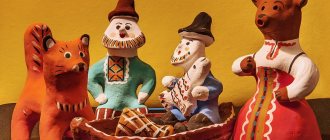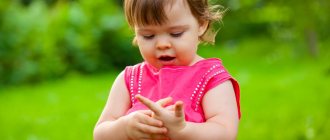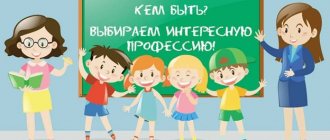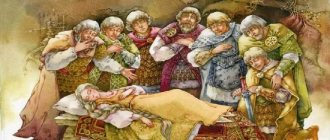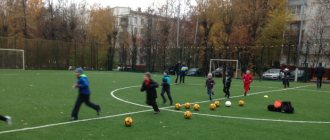Organization of a subject-development environment in a preschool educational institution on the topic: Folk crafts
Organization of a subject-developing spatial environment on the topic: “Folk crafts” in the educational field “Cognitive Development”
Author: Alla Ivanovna Efimova, teacher of GBDOU No. 43, Kolpino St. Petersburg Description: The material will be useful to educators and also interesting to parents. The material was accompanied by a presentation. Preschool age is the age of formation and development of the most general abilities, which will improve and differentiate as the child grows up. One of the most important abilities is the ability to cognition. Objectives of cognitive development: • To cultivate respect for the work of folk craftsmen. • To form positive emotional responsiveness when perceiving the works of folk artists. • Expand and consolidate children's ideas about Russian folk crafts. • Develop creative imagination, their independence in coming up with a drawing. • Enrich children's vocabulary. • Develop coherent speech. • Develop attention and cognitive activity. • Develop logical thinking and memory. (slide 2; 3) It is necessary to organize interaction with the child in such a way that it is aimed at developing cognitive interest, cognitive independence and initiative. The main forms of interaction that promote cognitive development: - involving the child in various types of activities; - use of didactic games; - application of teaching methods aimed at enriching creative imagination, thinking, memory, and speech development. Cognitive development involves the cognitive activity of a preschooler. And in order to support cognitive activity, it is necessary to rely on the cognitive interest of children. Folk decorative and applied art is one of the means of aesthetic education, helps to form artistic taste, teaches children to see and understand the beauty in the life around us and in art. Introducing children to folk art and crafts has a beneficial effect on the development of children's creativity. The nature of folk art, its emotionality, colorfulness, and uniqueness are effective means for developing mental activity in children and the all-round development of the child. The creativity of folk artists not only cultivates aesthetic taste in children, but also forms spiritual needs, feelings of patriotism, national pride, high citizenship and humanity. The child learns that wonderful colorful objects are created by folk craftsmen, people gifted with imagination, talent and kindness. (slide 4)
To form and develop cognitive interest, one should: - develop children’s creative abilities, create conditions for this, - strengthen each child’s faith in his own abilities, encourage him, and not weaken his interest with distrust and negative assessments; develop children's self-esteem. Folk arts and crafts participate in the comprehensive development of children, delighting them, expanding their concepts and ideas, and cultivating artistic taste. (Slide5) » Once upon a time there lived a miracle master. He settled in a deep forest, built a hut, made a table and a spoon, and carved wooden dishes. He cooked wheat porridge, but did not forget to sprinkle millet on the chicks. Once a firebird flew to his house, touched the cup with its wing, and it turned golden. And since then beauty has appeared - painted dishes! “You can ask your child a riddle: “All the leaves are like leaves, here every one is golden, people call this beauty... (Khokhloma). (slide 6;7;)
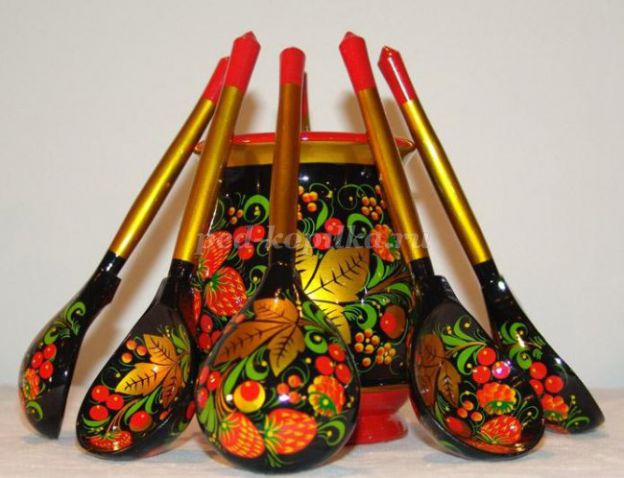
“Vesely Gorodets” There is an ancient city on the Volga, named Gorodets. He is famous throughout Russia for his painting, the creator. Bouquets are blooming, Bright colors of grief. It’s a miracle - birds flutter there, as if calling us to a fairy tale. If you look at the tablets, you will see miracles! Gorodets patterns were subtly drawn by hand! The Gorodets horse is running - the whole earth is trembling under it! It’s a miracle - birds flutter there, And water lilies bloom! As if calling us to a fairy tale! (slide8;9)
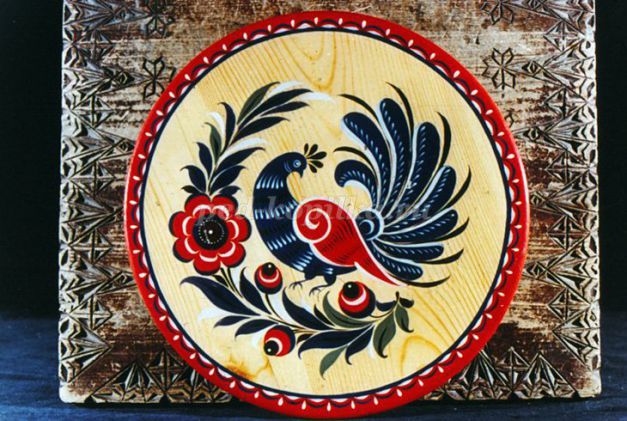
We recommend watching:
My favorite Kuban kindergarten Corner of theatrical activities for children of the first junior group Duty corner in kindergarten

Master Class. Twine well
Similar articles:
Do-it-yourself panels for decorating a corner of nature in a kindergarten
Aerodesign. Master Class
"Folklore as a means of developing children's cognitive abilities."
Author: Mandrovskaya Galina Anatolyevna
Article
"Folklore as a means of developing children's cognitive abilities."
The article was prepared by:
teacher of MKDOU
"Kindergarten "Teremok"
Mandrovskaya Galina Anatolevna
One of the most important tasks in the development of the personality of a preschool child is his mastery of the spiritual wealth, cultural and historical experience of the people, created over the centuries by a huge number of generations.
Oral folk art is the invaluable wealth of every nation, a view of life, society, nature developed over centuries, an indicator of its abilities and talent. The possibility of using oral folk art in a preschool institution for the development of cognitive activity of preschool children is determined by the specific content and forms of works of verbal creativity of the Russian people, the nature of familiarity with them and the speech development of preschool children. Children perceive folklore works well due to their simplicity, gentle humor, unobtrusive didacticism and familiar life situations.
“Thanks to folklore, a child enters the world around him more easily, more fully feels the beauty of his native nature, assimilates the people’s ideas about beauty, morality, gets acquainted with customs - in a word, along with aesthetic pleasure, he absorbs what is called the spiritual heritage of the people, without which the formation of a full-fledged personality is impossible " Oral folk art is the richest source of a child’s cognitive and moral development.
We have a new attitude towards Russian traditions and folklore, in which the people left us the most valuable of their achievements, sifted through the sieve of centuries. But, nevertheless, the modern child still has a weakly expressed sense of belonging to the Russian people, to its culture and traditions. Modern children play computer games, and do not play folk games, since there are almost no traditions when folk festivities were massive and children spent more time on the street than in the house, sitting at the computer. Therefore, I considered it necessary to convey to the children’s consciousness that they too are bearers of Russian culture. I try to show them how beautiful and interesting our Russian language is, how many-sided and diverse it is through the example of nursery rhymes, sayings, riddles, jokes, proverbs, chants and fairy tales.
Introducing children to works of art and the best examples of oral folk art must begin from the first days of a child’s visit to kindergarten, since the period of early and preschool childhood is a defining stage in the development of the human personality. The age of up to five years is the richest in a child’s ability to quickly and greedily learn about the world around him and absorb a huge amount of impressions.
In my work with children, I try to use all types of folklore as widely as possible (fairy tales, nursery rhymes, songs, chants, jokes, sayings, sayings, pesters, riddles, games, chants, etc.). Since they wisely teach the child, accustom him to the culture of his people, they contribute not only to the formation of an emotionally positive attitude towards the world as a miracle, but also contribute to the development of cognitive activity and cognitive interest in preschoolers.
To achieve a positive result in my work, I have outlined the following tasks:
• Enrich the consciousness of children with new content, which contributes to the accumulation of the child’s ideas about the big world, using oral folk art;
• To increase the interest in Russian folk art and folklore in the soul of every child;
• To form ideas about the spiritual richness, diversity and beauty of the culture of the native people through folklore works;
• Foster respect for Russian folk traditions.
In addition, I previously studied the relevant literature and took this into account when drawing up long-term planning; created a card index of folklore works; prepared the development environment; worked with parents.
I began my work with nursery rhymes and songs that use various parts of the body of a child and an adult, since nursery rhymes for young children are close to lullabies, in the nature of their performance, the nursery rhyme amuses with rhythm - it amuses, makes you happy. (“Water-water, wash my face”, “Finger-boy, where have you been?”, “Our little Masha”, “Bai-bai”, “Bai-bayushki-bai”, etc.). Then we moved on to familiarize ourselves with nursery rhymes about nature and natural phenomena (about the sun, about grass, about rain, about rainbows, about cockerels, etc.)
For middle-aged children, I began to use counting rhymes to distribute roles in the game. During the game, all children were chosen using a counting rhyme in order to fairly assign a driver. Using counting rhymes in the game develops moral qualities in children: to be able to be fair, not to be cunning, not to be an upstart.
Using chants in working with children helped me not only to attract children’s attention to nature, but also to develop an interest in folk art, their native language, and independent observations.
When working with proverbs and sayings, I selected them so that the meaning could be verified through observations, during conversation, experiments, etc. The first experience allowed them to be convinced that different plants grow from different seeds in shape and size (“ The seeds sprout." The second experiment showed that seedlings depend on the quality of the seeds (“Do not expect a good tribe from a bad seed”, “What you sow is what you reap”).
When the children had a question: Why are some trees and shrubs specially covered with snow? Why does the grass remain green under the snow? The children and I set up an experiment: we filled two bottles with warm water and placed them on a snowdrift and in the depths of it. The children concluded that snow retains heat. And I picked up proverbs for this experiment: “Snow is cold, but it protects you from the cold,” “A lot of snow means a lot of bread; a lot of water - a lot of grass.” Some proverbs and sayings helped to reveal cause-and-effect relationships in nature. For example: “The berry is red, but it tastes bitter.” We talked with the children about the literal and figurative meaning of the proverb and came to the conclusion that the saying “Not every red berry is ripe but tasty” speaks the truth. In classes such as “Visiting Grandma Arina”, “Visiting the Hostess”, “Gatherings”, “Grandma’s Hut”, I used proverbs on social relations. For example: “The hut for children is fun”, “The whole family is together, so the soul is in the place”, and the children, reasoning, concluded that they are having fun and good today because there are many of them, that they are friendly and cheerful.
In my work, I pay special attention to introducing children to Russian folk games and amusements. They carry a culture of communication, teach them to be attentive, kind, and preserve local traditions and customs. During folk activities, children’s ideas about their native country and national holidays expand, interest in events in the country is formed, love for the Motherland, for their native land is fostered.
The riddles I use in my classes serve as a test of wisdom. I try to use riddles in almost all classes to test knowledge, observation, and intelligence. I see the value of riddles in the fact that children begin to think, their attention is directed to objects and phenomena and their signs, the ability and certainty of thinking and the power of imagination increase.
In addition, riddles allow children to see the diversity of the world and reveal its secrets.
In my work, I chose a fairy tale as the main means of developing cognitive abilities. Because only a fairy tale, or a game of a fairy tale, can be opposed to a game as a leading activity in preschool age. At one time, the Russian writer and teacher K.D. Ushinsky highly valued the folk tale, considering it a wonderful method of influencing a child: “These are the first and brilliant attempts at folk pedagogy, and I don’t think anyone would be able to compete with the pedagogical genius people." With his favorite fairy tale characters, the child, unnoticed by himself, solves many problems and willingly overcomes difficulties in mastering new knowledge. A fairy tale with great generosity gives children joy, fun, and happiness.
Communicating with fairy-tale characters, children develop a deeper sense of relationships and norms of behavior, begin to understand elementary cause-and-effect relationships, and transfer fairy-tale events into real life. For example, such tales by R. n. fairy tales “The Wolf and the Little Goats”, “The Cat, the Rooster and the Fox”, “Kolobok” teach children the basics of safe life; the fairy tale “Zayushkina’s Hut” helps to learn about the properties of ice and wood; and the fairy tales “Teremok” and “Turnip” introduce children to the norms of behavior in a team.
In order to expand the child’s cognitive interests, I worked with the families of the pupils, using various forms: holidays, competitions and photo exhibitions, joint excursions to the mini-museum “Granny’s Hut”. Explanatory work was also carried out with parents about the need to look at pictures and paintings at home with their children, read literature and folklore works for children, showed a series of pictures, and a selection of works for children of a certain age. My parents provided me with great help in collecting visual and educational material to create a subject-spatial environment and design the Folk Art Corner in the group.
I believe that children's folklore is an important factor in educating the younger generation, which harmoniously combines spiritual wealth, moral purity and physical perfection.
And the results of observations allow us to draw conclusions about the positive influence of folklore on the development of cognitive abilities of preschool children. comments powered by HyperComments
